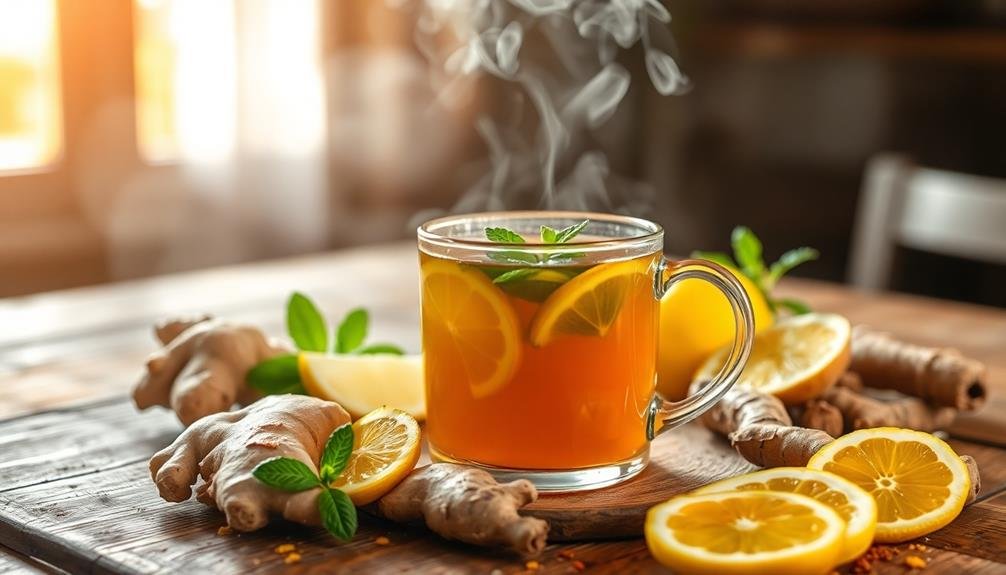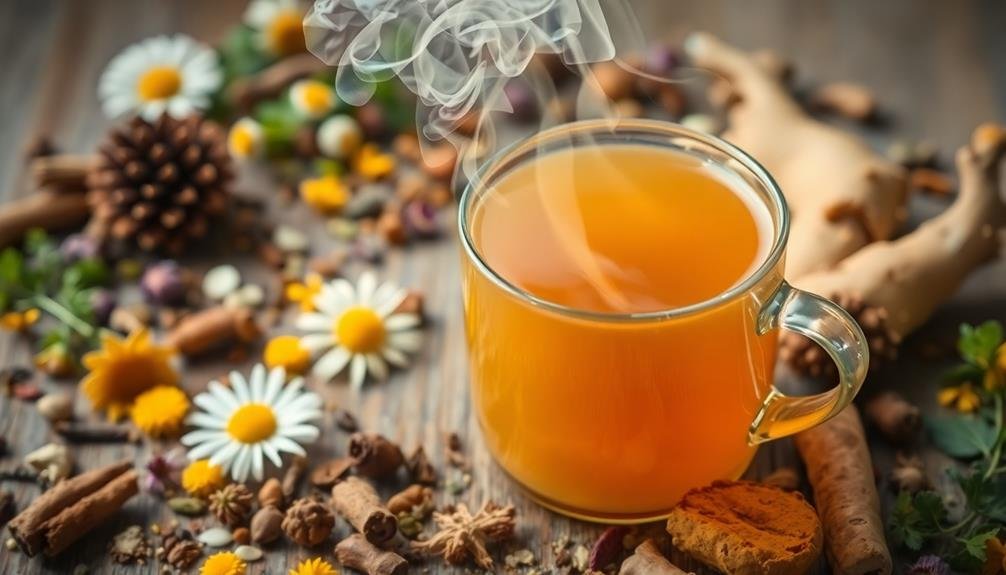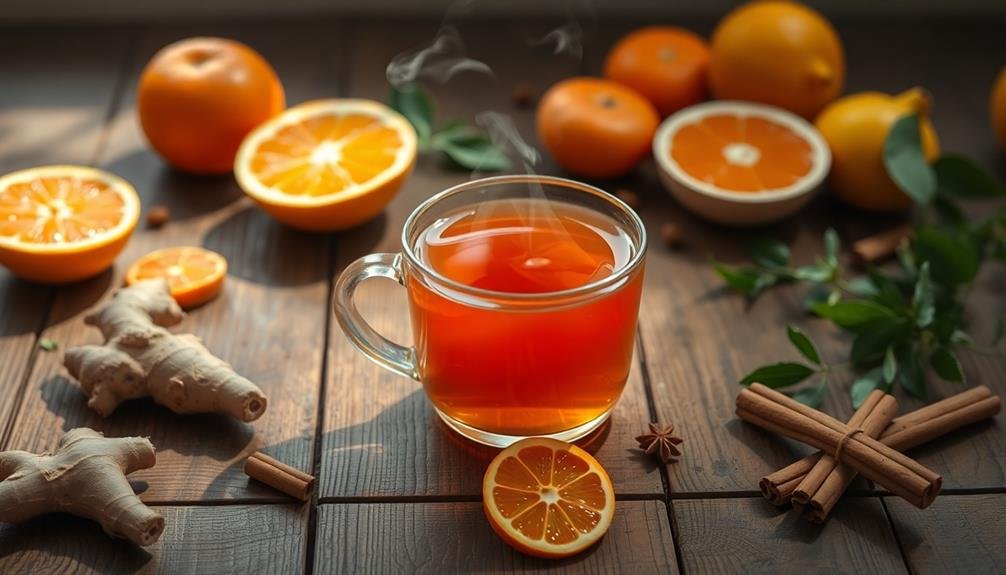Foraging responsibly for wild tea herbs is essential for maintaining healthy ecosystems and ensuring these plants thrive for future generations. When you forage, you should only take what you need and leave enough for the plants to regenerate. This practice helps preserve biodiversity and supports local wildlife. Additionally, mindful harvesting techniques prevent damage to habitats and promote better growth. By respecting local regulations and avoiding polluted areas, you contribute to the sustainability of wild tea herbs. If you want to enhance your foraging skills and learn more about these practices, there's plenty more to explore.
Understanding Sustainable Foraging

Sustainable foraging embodies a respect for nature that guarantees we can enjoy wild tea herbs without depleting their populations. When you forage, you're not just collecting herbs; you're engaging with the environment in a way that acknowledges its limits.
Understanding sustainable foraging means recognizing the delicate balance that exists in ecosystems. You should only take what you need, leaving plenty behind for wildlife and future foragers.
To forage sustainably, start by identifying the plants you want to collect. Make certain they're abundant in your area. Avoid overharvesting by taking no more than one-third of a plant population. This method guarantees that the herbs can regenerate and continue to thrive.
You'll also want to check for local regulations regarding foraging, as some areas may have restrictions to protect native species.
Additionally, practice mindfulness in your approach. Be aware of the environment around you and avoid areas that are polluted or treated with pesticides.
Benefits of Wild Tea Herbs
When you explore wild tea herbs, you're not just enjoying unique flavors; you're also tapping into their impressive nutritional benefits.
These herbs contribute to biodiversity and promote ecosystem health, making your foraging efforts worthwhile.
Plus, by practicing sustainable harvesting, you help preserve these natural treasures for future generations.
Nutritional Value and Benefits
What makes wild tea herbs a valuable addition to your diet? These herbs are packed with essential nutrients, antioxidants, and unique phytochemicals that can enhance your overall health. By incorporating them into your daily routine, you can tap into their numerous benefits.
For instance, many wild tea herbs, like nettle and dandelion, are rich in vitamins A, C, and K, which support immune function and skin health. They also contain minerals such as iron, calcium, and magnesium, vital for maintaining strong bones and proper bodily functions.
Moreover, wild tea herbs are known for their antioxidant properties, helping to combat oxidative stress and inflammation in your body. This can lead to a reduced risk of chronic diseases, such as heart disease and cancer.
Additionally, some wild tea herbs, like chamomile and lemon balm, have calming effects that can promote relaxation and improve sleep quality.
Biodiversity and Ecosystem Health
Foraging for wild tea herbs not only enriches your diet but also supports biodiversity and ecosystem health. When you collect these herbs, you contribute to the preservation of local flora and fauna.
By engaging with your environment, you help maintain the delicate balance of ecosystems, as diverse plant species encourage a variety of pollinators and other wildlife. Each time you forage responsibly, you promote genetic diversity, which is essential for resilience against pests, diseases, and climate change.
This diversity helps create a thriving environment where both plants and animals can flourish. You'll notice that harvesting herbs from varied locations can lead to a rich tapestry of flavors and health benefits, reflecting the unique characteristics of each ecosystem.
Moreover, your connection with nature fosters a deeper appreciation for the natural world, prompting you to advocate for its protection. As you learn about the plants you forage, you become an active participant in conservation efforts, helping preserve habitats for future generations.
In this way, your foraging practices not only boost your wellbeing but also contribute to the health of the planet, making a positive impact on biodiversity and ecosystem stability.
Sustainable Harvesting Practices
Sustainable harvesting practices offer numerous benefits for both you and the environment when it comes to wild tea herbs. By using responsible methods, you guarantee that the plants can regenerate and thrive for future harvests. This not only preserves the ecosystem but also helps maintain the rich biodiversity of the area, providing habitats for various wildlife.
When you forage sustainably, you're also enhancing the quality of the herbs you collect. Healthy plants produce more potent flavors and higher concentrations of beneficial compounds. This means your wild tea will be more enjoyable and potentially more healthful.
Plus, by respecting the natural cycles of the plants, you're fostering a deeper connection with the land and its resources.
Engaging in sustainable practices can also create a sense of community among fellow foragers. Sharing knowledge about responsible methods encourages a collective commitment to preserving nature. When everyone participates, it leads to healthier ecosystems and a more abundant supply of wild tea herbs.
Ultimately, sustainable harvesting practices allow you to enjoy the beauty and benefits of wild tea herbs while guaranteeing that they remain available for generations to come. So, make responsible choices and reap the rewards!
Identifying Safe Plants

While exploring the outdoors, it's crucial to confidently identify safe plants before you start brewing your wild tea. Familiarize yourself with common edible herbs, such as chamomile, mint, and lemon balm. Use a reliable field guide or app to help you distinguish between safe and toxic plants. Pay attention to specific characteristics like leaf shape, flower color, and growth habits.
When you're out foraging, always examine the environment. Plants growing in polluted areas or near roads can absorb harmful substances. Avoid any that appear wilted, discolored, or infested with pests. If you're unsure about a plant's identity, don't risk it—leave it be.
It's also wise to start with small amounts of any new herb you try. Even safe plants can cause allergic reactions in some individuals. Always research how to prepare and consume your foraged herbs properly.
Lastly, connect with local foraging groups or experienced foragers. They can provide valuable insights and help you learn to identify safe plants with confidence.
Seasonal Foraging Tips
When you're out foraging for wild tea herbs, timing is everything.
Knowing the best seasons to search for specific plants can greatly enhance your harvest.
Plus, recognizing which herbs are edible will guarantee you enjoy a safe and delicious experience.
Best Times to Forage
Foraging for wild tea herbs can be a rewarding experience, but timing is essential. Each season offers different opportunities for finding various herbs.
In spring, look for young, tender leaves that are bursting with flavor. This is when many herbs are at their peak, making it an excellent time to gather ingredients for invigorating teas.
As summer arrives, you'll notice a range of flowering herbs. This is the perfect time to forage for those that thrive in warmer weather, like chamomile and lemon balm.
Be mindful of the heat; early morning or late afternoon is best for foraging, as the sun can wilt delicate leaves.
Come autumn, some herbs may begin to die back, but others, like mint and sage, can still provide flavorful additions to your teas.
This is also the time to collect seeds if you're interested in growing your own herbs later.
In winter, foraging becomes trickier, but you can still find roots and dried herbs from late fall.
Keep an eye out for evergreen herbs that hold their flavor through the colder months.
Always respect nature, and remember to forage sustainably, ensuring the health of these plants for future seasons.
Identifying Edible Herbs
Knowing how to identify edible herbs is key to making the most of your foraging adventures. Start by familiarizing yourself with common wild herbs in your area. Use field guides or mobile apps to help you pinpoint specific plants. Remember, many edible herbs have toxic look-alikes, so double-check your findings.
During spring, keep an eye out for young leaves of dandelion or wild garlic. In summer, you'll find vibrant lemon balm and mint, both great for tea. As autumn approaches, look for the earthy flavors of chamomile and yarrow.
Winter foraging can be trickier, but you might still spot dried remains of stinging nettles or even some evergreen herbs.
Always observe the plant's growing conditions, habitat, and smell. Fresh herbs often have distinct aromas, while many toxic plants smell unpleasant. If you're unsure about a plant's edibility, don't risk it. It's better to leave it be than to face potential consequences.
When you confidently identify edible herbs, you'll enhance your foraging experience and enjoy the rewards of nature's bounty safely. Happy foraging!
Ethical Harvesting Techniques

Harvesting wild tea herbs ethically guarantees the sustainability of both the plants and their ecosystem. When you forage responsibly, you do more than just collect herbs; you contribute to the health of the environment.
Here are some crucial ethical harvesting techniques to keep in mind:
- Leave No Trace: Take only what you need and guarantee you leave the area as you found it. This helps maintain the habitat for other plants and wildlife.
- Use Clean Tools: Always use sanitized tools to prevent the spread of disease among plants. This simple step protects the integrity of the ecosystem.
- Know Your Limits: Familiarize yourself with local regulations regarding wild harvesting. Respecting these boundaries not only protects nature but also guarantees you can forage again in the future.
- Harvest Mindfully: Avoid uprooting entire plants. Instead, pick leaves or flowers, allowing the plant to continue growing and thriving.
Preserving Plant Populations
Sustaining wild tea herbs goes hand in hand with preserving plant populations in their natural habitats. When you forage, you're not just gathering ingredients; you're also playing an important role in maintaining biodiversity. Overharvesting can lead to a decline in plant populations, which disrupts ecosystems and reduces the availability of these herbs for future generations.
To preserve plant populations, start by learning about the specific species you're interested in. Understand their growth patterns, habitat preferences, and reproductive cycles. Harvest only what you need, and always leave enough behind to make sure that the plants can regenerate.
It's vital to be mindful of your surroundings and avoid trampling on delicate ecosystems while foraging. Consider practicing rotational harvesting, where you alternate foraging sites to give plants time to recover.
You might also want to educate others about the importance of sustainable foraging practices. By sharing your knowledge, you can help foster a community that values and protects wild tea herbs.
Ultimately, when you prioritize preserving plant populations, you're contributing to the health of the environment and making certain that these natural treasures remain available for everyone to enjoy.
Creating Herbal Tea Blends

Creating your own herbal tea blends can be a delightful and rewarding experience. By mixing different herbs, you not only craft unique flavors but also tailor the health benefits to suit your needs.
Here's how you can get started:
- Choose a Base: Select a primary herb that will be the foundation of your blend. Chamomile, mint, or hibiscus are all excellent choices.
- Add Complementary Herbs: Look for herbs that enhance the flavor and health benefits of your base. For instance, pairing chamomile with lemon balm can create a soothing blend.
- Incorporate Flavor Enhancers: Consider adding spices or citrus peels for an extra kick. Ginger or orange zest can elevate your tea to new heights.
- Experiment and Adjust: Don't be afraid to tweak your blend. Taste it as you go, and adjust the ratios until you find your perfect combination.
Frequently Asked Questions
What Tools Do I Need for Foraging Wild Tea Herbs?
You'll need a sturdy basket for collecting, scissors or shears for cutting, gloves to protect your hands, a field guide for identification, and a water bottle to stay hydrated while exploring the outdoors.
Can I Forage in Urban Areas for Wild Tea Herbs?
Yes, you can forage in urban areas for wild tea herbs. Look for parks, gardens, and green spaces. Just be mindful of pollution and avoid areas treated with pesticides to guarantee the herbs are safe.
Are There Any Legal Restrictions on Foraging in Certain Locations?
Yes, there are legal restrictions on foraging in certain locations. You should always check local laws and regulations, as some parks or private properties prohibit foraging to protect ecosystems and guarantee sustainable practices.
How Do Weather Conditions Affect the Availability of Wild Tea Herbs?
Weather conditions greatly impact wild tea herbs' growth and availability. When it's too dry or wet, you'll find fewer herbs. Observing seasonal changes helps you identify the best times to forage for these plants.
What Should I Do if I Encounter Wildlife While Foraging?
If you encounter wildlife while foraging, stay calm and back away slowly. Avoid sudden movements or loud noises. Give the animal space, and remember to respect their habitat by observing from a safe distance.
In Summary
Foraging for wild tea herbs can be a rewarding experience, but it's essential to do it responsibly. By understanding sustainable practices, identifying safe plants, and using ethical harvesting techniques, you'll help preserve these valuable resources for future generations. Remember, the joy of crafting your own herbal tea blends comes with the responsibility to protect nature's bounty. So, get out there, explore, and enjoy the rich flavors of wild tea while ensuring these plants thrive in their natural habitat.





Leave a Reply